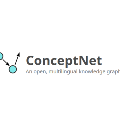Humans use countless basic, shared facts about the world to efficiently navigate in their environment. This commonsense knowledge is rarely communicated explicitly, however, understanding how commonsense knowledge is represented in different paradigms is important for both deeper understanding of human cognition and for augmenting automatic reasoning systems. This paper presents an in-depth comparison of two large-scale resources of general knowledge: ConcpetNet, an engineered relational database, and SWOW a knowledge graph derived from crowd-sourced word associations. We examine the structure, overlap and differences between the two graphs, as well as the extent to which they encode situational commonsense knowledge. We finally show empirically that both resources improve downstream task performance on commonsense reasoning benchmarks over text-only baselines, suggesting that large-scale word association data, which have been obtained for several languages through crowd-sourcing, can be a valuable complement to curated knowledge graphs
翻译:人类利用无数关于世界的基本、共享的基本事实,在他们的环境中有效航行。但很少明确传播这种常识知识,但很少明确传播这种常识知识,了解普通常识如何在不同范式中体现,对于更深入地理解人类认知概念和增强自动推理系统都很重要。本文对两种大范围的普通知识资源进行了深入比较:ConcpetNet(一个工程化的关系数据库)和SWOW(一个从众源词汇协会获得的知识图)。我们审查了两个图表的结构、重叠和差异,以及它们将常识知识编码化的程度。我们最后从经验上表明,两种资源都改善了关于仅用文本基线的常识推理基准的下游任务业绩,表明通过众包为多种语言获得的大规模词汇联系数据,可以成为整理知识图的宝贵补充。




